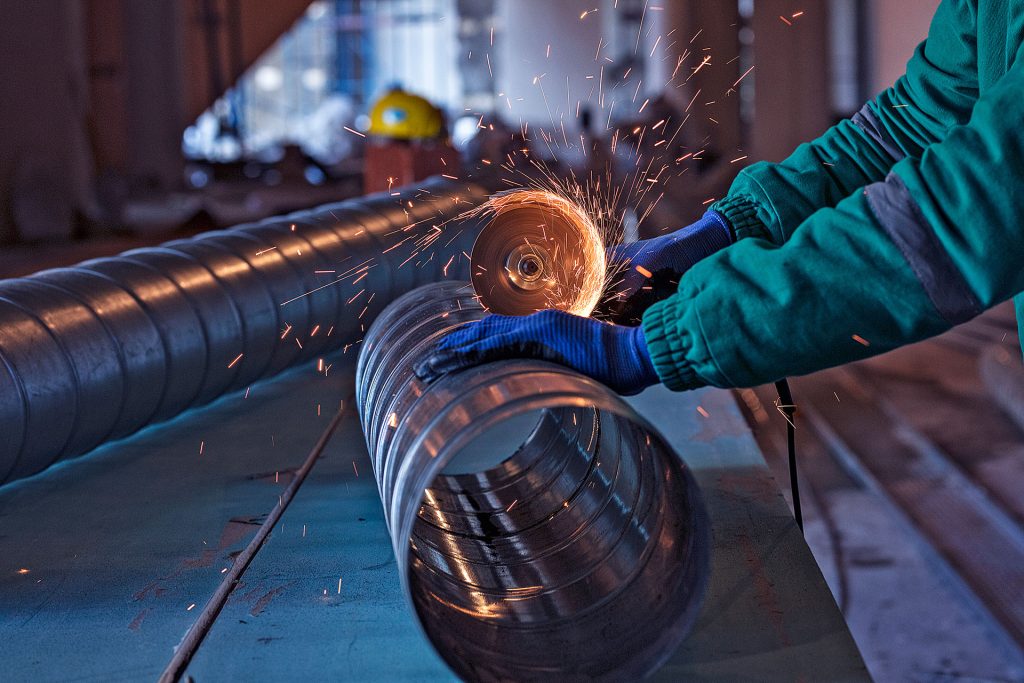Steel fabrication is the cornerstone of many industries, from construction and transportation to machinery and consumer goods. This intricate process transforms raw steel into customised shapes and components, tailored to specific applications. Its significance cannot be understated, as it ensures the durability, strength, and precision of structures and products that we use daily.
The art of steel fabrication is not just about bending and cutting metal. It demands a high level of precision and expertise. Each step, whether it’s bending, notching, cutting, or guillotining, must be executed with utmost accuracy to ensure the final product meets the desired specifications and standards. A slight deviation can compromise the integrity and functionality of the end product.
Metro Steel boasts a purpose-built premise equipped with a plethora of machinery and equipment tailored to meet the highest industry standards. But it’s not just about the machinery; the real magic lies in the hands of their highly experienced tradesmen. These experts not only bring project ideas to life but also ensure timely delivery, understanding that for many clients, time equates to money.
Steel Fabrication: Step-by-Step Guide
Step 1. Understanding the Client’s Needs
In the realm of steel fabrication, the journey to a successful project begins with a clear understanding of the client’s needs. This step is paramount, as it lays the foundation for the entire fabrication process. Clear communication between the fabricator and the client ensures that both parties are aligned in terms of expectations, requirements, and desired outcomes. By thoroughly comprehending the nuances of a project, potential challenges can be anticipated and addressed, ensuring a smoother workflow and a product that aligns perfectly with the client’s vision.
Step 2: Design and Blueprint Creation
Once the client’s needs are crystal clear, the focus shifts to the creation of detailed designs and blueprints. These are not mere drawings but the very roadmap that guides the fabrication process. A comprehensive design and blueprint ensure that every cut, bend, and weld is executed with precision. They serve as the guiding light, ensuring that the fabricated piece is both functional and aesthetically pleasing. In essence, the significance of meticulous designs and blueprints cannot be overstated, as they are the linchpins ensuring the project’s success from inception to completion.
Step 3. Material Selection
Material selection is a pivotal step in the steel fabrication process. The type of steel chosen can significantly influence the durability, strength, and finish of the final product. It’s not a one-size-fits-all approach; different projects have unique requirements. Whether it’s corrosion resistance, tensile strength, or flexibility, the right type of steel can make all the difference. By aligning the material’s properties with the project’s needs, fabricators ensure that the end product not only meets but exceeds client expectations.
Step 4. Cutting
Cutting is one of the primary processes in steel fabrication, setting the stage for the shape and size of the final product. There are various methods employed to cut steel, each with its own set of advantages. Guillotining, for instance, is a popular method known for its precision and ability to handle large sheets of metal. By using sharp blades and applying significant force, guillotining ensures clean and straight cuts, making it an ideal choice for many projects. The method chosen often depends on the project’s specifications, ensuring the best possible outcome in terms of accuracy and finish.
Step 5. Bending
Bending is a delicate balance of art and science, transforming flat sheets of steel into intricate and functional shapes. This process requires a deep understanding of the material’s properties, ensuring that the steel is bent without compromising its strength or integrity. Advanced machinery, combined with expert knowledge, allows fabricators to achieve precise angles and curves, catering to the specific needs of the project. Whether it’s creating structural beams or crafting aesthetic designs, bending is instrumental in bringing the vision to life.
Step 6. Notching
Notching is a specialised process in steel fabrication where specific portions of the material are removed to facilitate assembly or enhance the design. This technique is crucial for creating joints, allowing separate pieces to fit together seamlessly. By ensuring accurate and consistent notches, fabricators can guarantee a snug fit and robust connections, vital for the structural integrity of the final product. In essence, notching is more than just cutting out sections; it’s about precision and ensuring each piece comes together in harmony.
Step 7. Punching and Cropping
Punching and cropping play a pivotal role in adding the finer details to steel components. Punching involves creating holes of various sizes and patterns in the steel, allowing for bolting, riveting, or other assembly methods. This process ensures that components can be interconnected with precision. Cropping, on the other hand, refers to the removal of unwanted sections from the steel’s edges, ensuring a clean finish and the desired shape. Together, these techniques enhance the functionality and aesthetics of the fabricated piece, ensuring every detail aligns with the project’s specifications.
Step 8. Rolling
Rolling is a transformative process in steel fabrication, taking flat steel sheets and turning them into cylindrical shapes. This technique is essential for creating components like pipes, tubes, and tanks. By passing the steel between heavy rollers, fabricators can achieve the desired curvature and diameter. The result is a perfectly rounded piece, tailored to the project’s requirements. Whether it’s for structural purposes or fluid transportation, rolling ensures steel can be moulded to fit a myriad of applications.
Step 9. Joining and Welding
Joining and welding are fundamental processes in steel fabrication, ensuring that individual pieces come together to form a cohesive whole. Welding involves using intense heat to melt and fuse steel components at their joining points, creating a strong and durable bond. Various methods, such as MIG, TIG, and stick welding, are employed depending on the project’s requirements. These techniques ensure that the final structure is robust, with joints that can withstand significant stress and wear.
Step 10. Finishing and Quality Control
Once the fabrication is complete, the focus shifts to the finishing touches. This step involves processes like grinding, polishing, and painting to enhance the product’s appearance and protect it from environmental factors. But it’s not just about aesthetics; quality control is paramount. Rigorous inspections are conducted to ensure that the final product adheres to the highest standards, both in terms of design and durability. Any discrepancies are addressed promptly, guaranteeing that the client receives a product of impeccable quality.
Step 11. Delivery and Installation
The culmination of the steel fabrication process is the delivery and installation of the final product. Timely delivery is crucial, as it ensures that projects remain on schedule. Once on-site, expert teams oversee the installation, ensuring that each component fits perfectly and functions as intended. This step is vital for client satisfaction, as it’s the tangible realization of their vision. Proper installation ensures not only the longevity of the product but also the safety and satisfaction of the end-users.
Why Choose Metro Steel for Steel Fabrication in Brisbane?
Selecting Metro Steel is not just about choosing a service; it’s about partnering with a legacy. Their expertise, coupled with state-of-the-art machinery and a team of dedicated professionals, ensures that every project is executed to perfection. With Metro Steel, clients are not just assured of quality but also of a partner who understands their vision and transforms it into tangible reality.
Forge Ahead with the Best
When it comes to steel fabrication, settling for anything less than the best is not an option. Your projects deserve precision, expertise, and a touch of craftsmanship. Don’t leave it to chance; consult the experts. With Metro Steel’s proven track record and commitment to excellence, you’re not just getting a service—you’re investing in a partnership that values your vision. Contact Metro Steel today and elevate your projects to unparalleled heights.
 Talk to an Expert (07) 3204 1000
Talk to an Expert (07) 3204 1000 Working Hours - Mon – Fri 7:00 AM – 4:00 PM
Working Hours - Mon – Fri 7:00 AM – 4:00 PM
